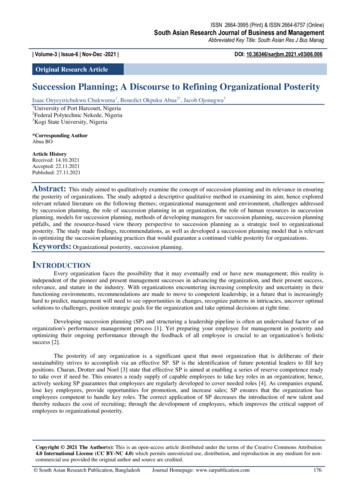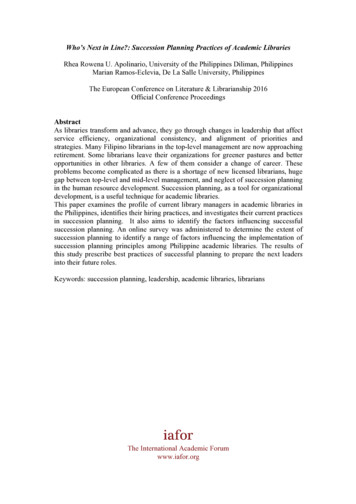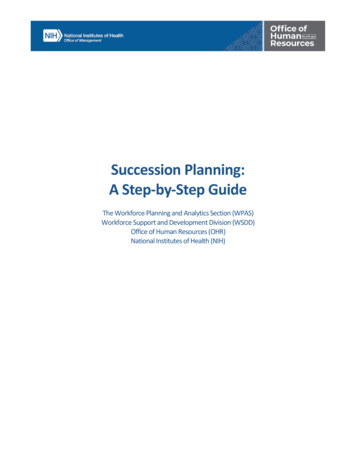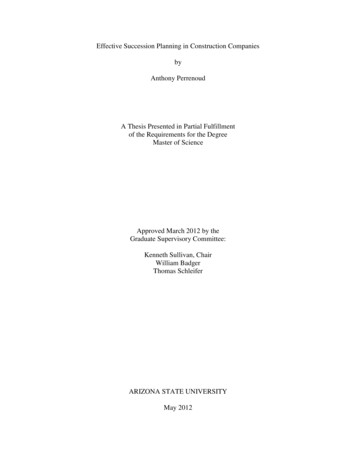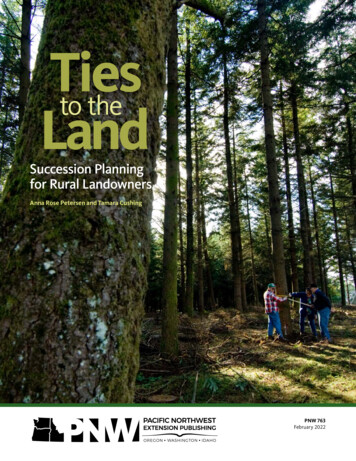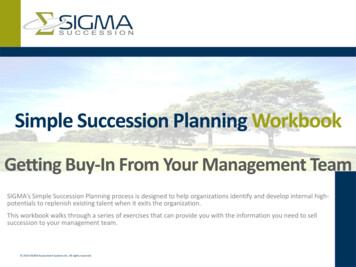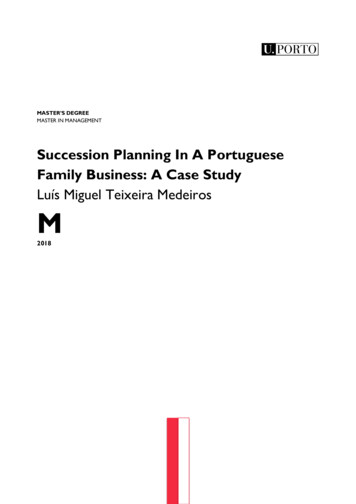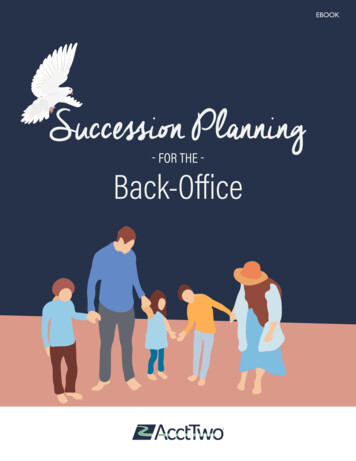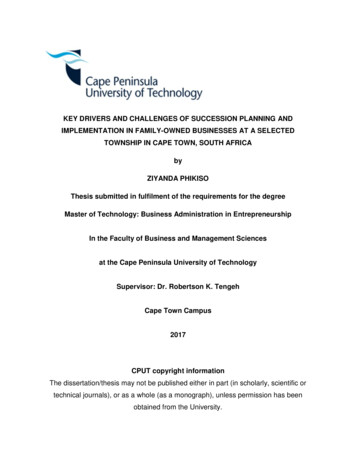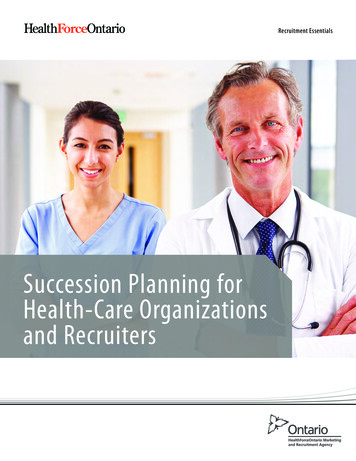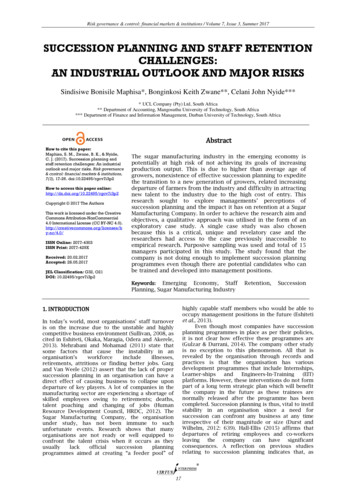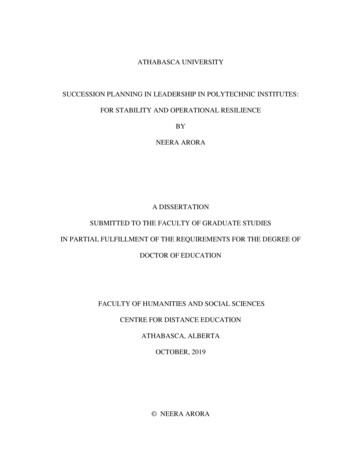
Transcription
ATHABASCA UNIVERSITYSUCCESSION PLANNING IN LEADERSHIP IN POLYTECHNIC INSTITUTES:FOR STABILITY AND OPERATIONAL RESILIENCEBYNEERA ARORAA DISSERTATIONSUBMITTED TO THE FACULTY OF GRADUATE STUDIESIN PARTIAL FULFILLMENT OF THE REQUIREMENTS FOR THE DEGREE OFDOCTOR OF EDUCATIONFACULTY OF HUMANITIES AND SOCIAL SCIENCESCENTRE FOR DISTANCE EDUCATIONATHABASCA, ALBERTAOCTOBER, 2019 NEERA ARORA
iiApproval Page
iiiDedicationI am dedicating this dissertation to my mother, Santosh Sharma, for being myinspiration and instilling in me the importance of pursuing your passion with hard work, strongwork ethic and perseverance while keeping family and relationships at the core of everything.Her selfless and tenacious disposition and endurance throughout her life taught me to navigatemy world with confidence and always balance my personal and professional lives.
ivAcknowledgementIt takes a village to raise a child; I have a village to thank for their unwavering faith andsupport during my doctoral journey. I would like to thank my husband, Inder Arora, who hasbeen my rock and encouraged me to get on this journey when I was doubting myself. Thankyou for being a team player and my biggest supporter as we balanced our lives and celebrated afew memorable family accomplishments. Thank you to our children, Eesha, Dilan and Rahillfor being my source of motivation and keeping me in touch with reality; may you continue toexcel, be lifelong learners and stay determined to achieve your dreams, for they are achievablewhen pursued with passion, determination and hard-work. Thank you to my pooch, Dexter,who has been the light in my life and stress-buster during times when I needed it the most. Andto our village including all my family and friends for your unconditional love andencouragement.Thank you to my supervisor, Dr. Marti Cleveland-Innes, for her exemplary guidanceand support and for her responsiveness. Every phone conversation with her got me energizedand driven to pursue the topic of study that I have been passionate about. I know, I wouldn’thave been able to do it without Dr. Marti’s encouragement. Thank you to my committeemembers, Dr. Alan Davis and Dr. Mohamed Ally for their wise counsel, keen interest, andongoing support and interest in my research. I consider myself very fortunate to have had achance to work under the guidance of such exemplar scholars and practitioners. Thank you toall the leaders at my institution that have inspired, influenced and supported my research.And it would be a huge miss, if I did not recognize and thank my EdD cohort buddies. You allare key contributors to my success, and I can’t thank you enough for your time, genuinesupport and going the extra mile to be there for each other throughout this journey.
SUCCESSION PLANNING IN HIGHER EDUCATIONvAbstractThis grounded theory study examined succession planning for senior leadership positions withinpolytechnic institutes. Sixteen senior leaders from three polytechnic institutes in Canada wereinterviewed about their institutes’ existing senior leadership recruitment, retention, and trainingpractices and any alignment between strategic planning and succession planning efforts. Additionaldata were collected from institutional websites and strategic documents shared by the interviewedleaders. This study explored the role of strategic planning, organizational leadership, and theoverall talent management framework in addressing internal and external challenges faced byhigher education institutions due to changes in technological; student demographic; and sociopolitical and economic influences. The findings revealed a desire among senior leaders forsuccession planning to be a strategic and an ongoing conversation at all levels. Six themesemerged: institutional strategy, accountability, leadership development, talent management,essential leadership skills, and informal succession planning. Through examination of thesethemes, this study proposed the 4P Model for Succession Planning in Polytechnic Institutes,centered on Purpose, Progression, Performance, and Persistence.Keywords: polytechnic institutions, leadership development, strategic plan, talent management,succession planning
SUCCESSION PLANNING IN HIGHER EDUCATIONviTable of ContentsApproval Page . iiDedication . iiiAcknowledgement . ivAbstract .vTable of Contents . viList of Figures . ixList of Tables .xChapter 1. Introduction .1Research Problem . 7Research Purpose . 7Research Background . 8Polytechnics . 9Leadership Recruitment and Retention Challenges . 10Leadership Management Considerations . 12Research Framework . 13Succession Planning within the Digital Paradigm . 15Research Question . 17Significance of the study. 17Remainder of the Study . 18Summary . 20Chapter 2. Review of the Literature .22Polytechnics . 22Strategic Planning . 26Leadership . 27Leadership Theories . 28Complexity Leadership Theory . 29Transformational Leadership Theory . 31Succession Planning Definition . 32Succession Planning Evolution . 33Succession Planning Strategies . 36Job-ladder model.37Replacement strategy .38Career lattice .38External hiring .38Factors Influencing Succession Planning . 39Role of Strategic Planning and Leadership Development . 43Best Practices in Succession Planning . 44Literature Review Strategy . 46Succession Planning Components: Conceptual Framework. 47Polytechnic Institutions. .48Strategic Planning. .49
SUCCESSION PLANNING IN HIGHER EDUCATIONviiLeadership. .50Leadership Core Competencies and Recruitment .51Leadership Training and Development. .52Summary . 52Chapter 3. Theoretical Framework .54Introduction . 54Statement of the Problem . 54Research Purpose . 54Chapter 4. Methods .56Introduction . 56Theoretical Position . 56Grounded Theory Approach . 57Grounded Theory Design . 59Research Questions . 61Research Instrument. 62Participating Institutes and Research Participants . 62Sample Group . 63Data Collection . 63Data Analysis . 65Open coding .65Writing of memos .66Axial coding .66Selective coding .66Anticipated Results . 69Limitations and Delimitations. 69Ethical and Credibility Considerations and other Dilemmas . 70Summary . 71Chapter 5. Findings .73Introduction . 73Section One: Websites . 73Polytechnic A. .74Polytechnic B .75Polytechnic C .76Section Two: Interviews . 77Summary . 82Chapter 6. Discussion .84Theme 1: Institutional Strategy. 86Theme 2: Accountability Framework . 88Theme 3: Leadership Development Framework. 89Theme 4: Talent Management Strategy . 90Theme 5: Essential Leadership Skills . 92Theme 6: Informal Succession Planning . 94Generating Theory: 4P Model for Succession Planning in Polytechnic Institutes . 96Succession Planning Purpose.97Succession Planning Progression.99
SUCCESSION PLANNING IN HIGHER EDUCATIONviiiSuccession Planning Performance. .101Succession Planning Persistence .103Strengths and Limitations . 105Summary . 107Chapter 7. Conclusion .109Research Generalizability Validity . 110Recommendations . 111Recommendations for Future Research . 116Summary . 117References .119Appendix A: Letter of Information .137Appendix B: Participant Informed Consent .141Appendix C: Interview Script .144Appendix D: Open Coding .146Appendix E: Axial and Selective Coding .151Appendix F: Certification of Ethical Approval .152
SUCCESSION PLANNING IN HIGHER EDUCATIONixList of FiguresFigure 1. Complexity Leadership. . . 30Figure 2. Human Capital Management Variables. 37Figure 3. People Equity - ACE Model . 45Figure 4. Succession planning components. . 47Figure 5. Talent Management, Succession Planning and Leadership Development. . 50Figure 6. Research Approaches and Design Process -. 59Figure 7. Researcher's Approach. . 60Figure 8. Levels of Abstraction Grounded Theory . 66Figure 9. Example of formation of Open Code and Axial Code. . 79Figure 10. Example of formation of Open, Axial and Selective Codes. . 82Figure 11. 4Ps of Succession Planning using Grounded Theory. . 96
SUCCESSION PLANNING IN HIGHER EDUCATIONxList of TablesTable 1: Snapshot of Open Codes Concepts . 78Table 2: Open and Axial Code Applications using Dadoose . 80Table 3: Themes from Open and Axial Codes. 81
SUCCESSION PLANNING IN HIGHER EDUCATION1Chapter 1. IntroductionHigher education institutions are faced with the challenges of reduced governmentfunding (Barr & Turner, 2013), the high pace of change, and higher levels of accountability fromthe key stakeholders (Abadie-Mendia, 2013). In response, these institutions are required to adoptinnovative systems and data analytics to enhance learner success, academic integrity andsustainable growth (Green, 2014). These institutions are governed by different levels ofgovernment and operate within sophisticated sociotechnical networks of system, regulatorystandards, performance metrics, dashboards and data analytics technologies for meeting thereporting accountabilities and to support market reform (Williamson, 2018). Uhl-Bien, Marion,and McKelvey (2007) state that there has been a noteworthy change as we transitioned from theIndustrial Era to the Knowledge Era, resulting in a huge focus on the product and process ofknowledge creation, storage, and distribution. The subsequent emergence into the Digital Erahas led to changes like social media influence; the integration of online, blended, andcollaborative learning environments; the importance of data analytics and fact-based decisionmaking systems; and the shift of students from consumers to creators of information (Coccoli,Guercio, Maresca, & Stanganelli, 2014). Finally, reduced government funding, changing studentdemographics, technological advancements and their impacts on faculty duties within theshifting academic paradigm have made the higher education governance and operatingenvironment highly complex. This has required the leadership bench strength at all levels of theorganization, particularly in senior leadership positions, to stay nimble and operationally astuteto navigate through current realities and position the organization for long term growth andsustainability (Dickeson, 2010).
SUCCESSION PLANNING IN HIGHER EDUCATION2Post-secondary institutions have been impacted by the massification and globalization ofhigher education resulting in significant changes in the numbers and diversity of studentpopulations. Massification is the expansion of higher education due to the greater need anddemand for access. “Globalization is a process that encompasses the causes, course, andconsequences of transnational and transcultural integration of human and non-human activities”(Al-Rodhan & Stoudmann, 2006, p. 5). Massification and globalization has resulted in anunprecedented growth in the number of international students attending colleges and universities.Due to reduced government funding that limits domestic student enrolments and tuition caps,higher education institutions are gravitating towards expanding the quota for internationalstudents, as the international students pay significantly higher fees making internationalization ahelpful model for institutional financial stability. While this internationalization has contributedto institutional growth, improved partnerships, global reputation and student diversity oncampus, it has also resulted in numerous challenges (Knight, 2015). Usher (2018) cautionshigher education executives that the trend can reverse quickly as soon as the demographics ofdomestic students change in Canada, requiring them to replace the international students. Thisputs higher education institutions at risk if they are unable to respond to rapid changes in thedemographics of students. This will prompt an urgent need for action to change the financialgovernance of the organization and less reliance on revenue from international students.Embracing and adapting to this shifting landscape calls for entrepreneurial, innovative,agile and smart governance lead by bold leaders with a strategic vision and clear direction for theorganization. While these institutions are striving towards nimble and smart governance and seeinternationalization critical to support for overall growth and sustainability, they are struggling tohire and maintain executive leadership bench strength that understands various administrative
SUCCESSION PLANNING IN HIGHER EDUCATION3nuances including the development and implementation of institutional strategy, and have thetechnical and business competence to build smart operations leveraging digitalization and dataanalytics.Higher education in Canada can be classified into two categories; universities and nonuniversities. Generally, universities grant academic and professional undergraduate and graduatecredentials and the non-university cluster (community colleges, polytechnic institutes and privatecolleges) offer mainly apprenticeship training, grant certificates, diplomas and appliedundergraduate degrees (Teichler, 2007). For example, according to the Alberta CredentialFramework (2018), graduate level credentials include master’s and doctoral degrees; graduatecertificates and diplomas; post-master’s certificates and diplomas; and post-doctoral certificatesand diplomas; and undergraduate level credentials include certificates, diplomas, bachelor’sdegrees, post-diploma certificates, and post-bachelor’s certificates. Irrespective of what type ofhigher education it is, there is an expectation from the government and other funding institutionsfor accountability and good governance to ensure academic integrity and positive contributionfor the economic development and advancement of society. Knowledge and developing humancapital are the biggest drivers for productivity and economic development of a country andhigher education institutions play a critical role in advancing that mandate and policy reforms(Fuente & Ciccone, 2003). Employers and professional associations advocate that highereducation institutions need to be deliberate, nimble, and adaptive to the pace of change anddevelop a workforce built of highly skilled human capital.Within the larger higher education ecosystem, this study focuses on polytechnicinstitutions in Canada and examines the practices for succession planning for senior leaders inthese institutions. This study defines polytechnic institutions as “institutions which deliver
SUCCESSION PLANNING IN HIGHER EDUCATION4career-focused applied education that spans trades through advanced degrees, delivered in anenvironment where students receive hands-on training that enables them to more readily applytheir skills” (Polytechnics Canada, 2007). Additionally, Polytechnics engage in applied research,international activities, and partnerships with businesses as an integral part of the organizationalmandates.Polytechnics are gaining popularity because of their success in maintaining high graduateemployment rates that contribute to the growth and economic stability of individuals andcommunities. Partnerships with industry researchers and employers to develop industry-relevantprograms and to hire graduates is fundamental to polytechnics’ entrepreneurial operating modelthat promises industry relevant applied education training with an emphasis on applied research.This supply and demand of higher education cannot be refuted (Youssef & Hunter, 2010).Through their partnerships with industry and government, polytechnics have been successful inaddressing the gap between labour shortage and the market demand. Polytechnics focus on theirmandate of applied learning and achieve this through a collaborative and consultative effort withindustry stakeholders to integrate applied research and learning outcomes relevant for the jobs.The applied research focus within polytechnics offers the opportunity for theseinstitutions to work with small to medium-sized enterprises (SMEs) on innovative ideas anddevelop and test prototypes, while the SMEs benefit by using the technical facilities, subjectmatter experts and students (Luke, 2013). Due to the recent economic downturn in Canada andincreased regulatory requirements, industry is relying on innovation and technical interventionsto elevate operational efficiency and minimize costs. Partnering with polytechnics toconceptualize, develop, and test new ideas serves the SMEs well because of their low cost testingenvironment and financial viability. The SMEs and polytechnics share the capital and personnel
SUCCESSION PLANNING IN HIGHER EDUCATION5costs in order to build and test the prototypes – a win-win partnership. The dominance ofinnovation and technology advancement makes the applied research mandate critical, requiringthe right type of leadership to leverage the partnership opportunities and institutional strengthswhile garnering increased industry and government support.Polytechnics are adapting to changes in tuition fee models. Since the mid-1990’s, agreater proportion of Canadian post-secondary institution revenue is generated as a result of anincrease in student tuition fees (especially international student fees in some provinces) and adecrease in government funding (Kirby, 2011; Canadian Association of University Teachers2009). Rather than increasing funding to the institutions, the federal and provincial governmentshave shifted the funds towards students and their families or sponsors instead. In someprovinces, growth in international students has been mandated in order to develop revenuestreams and support the federal government’s decision to attract more international students andachieve a target of 450,000 in Canada by 2022 (Canada’s International Education Strategy,2014). Additionally, there has been a tuition freeze or cap by certain provincial governmentsrestricting that revenue channel for the institutions. This shift has resulted in increased pressureon the institutions to maintain their operations and find new ways of revenue generation to offsetthe increase in operational costs. This phenomenon requires higher education institutions to beinnovative and in-tune with technological advancements to stay competitive for operationaleffectiveness and find new ways to increase student enrolment and revenue, for example byinvesting in modalities like distance education and programs with alternative credentials. Fong,Janzow and Peck (2016), posit that employers are seeing more business value out of alternativecredentials, which are “competencies, skills, and learning outcomes derived from assessmentbased, non-degree activities and align to specific, timely needs in the workforce” (p1). Amirault
SUCCESSION PLANNING IN HIGHER EDUCATION6and Visser (2010) state that “Today’s technological revolution, with its order of magnitudeadvances that have left little of common life unchanged, presents an open challenge t
SUCCESSION PLANNING IN LEADERSHIP IN POLYTECHNIC INSTITUTES: FOR STABILITY AND OPERATIONAL RESILIENCE BY NEERA ARORA A DISSERTATION SUBMITTED TO THE FACULTY OF GRADUATE STUDIES . inspiration and instilling in me the importance of pursuing your passion with hard work, strong
